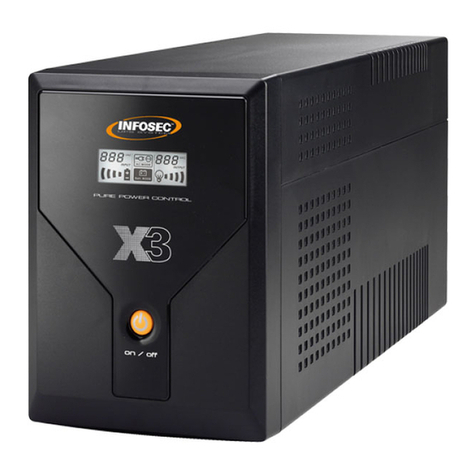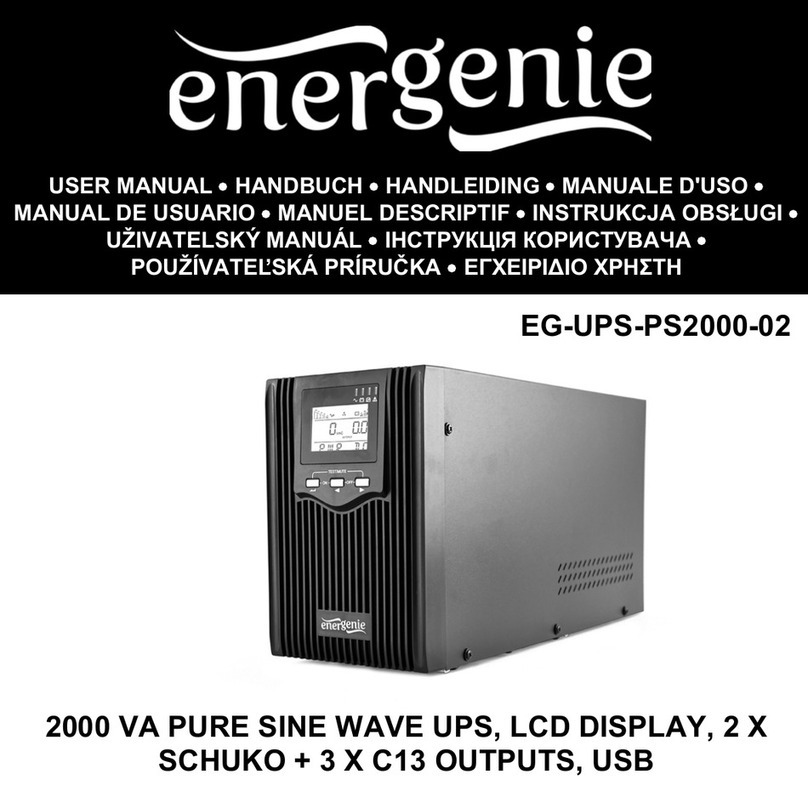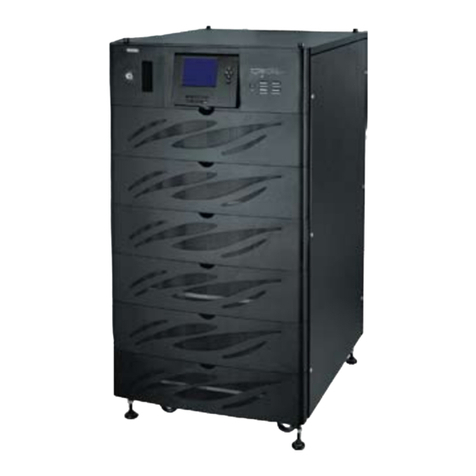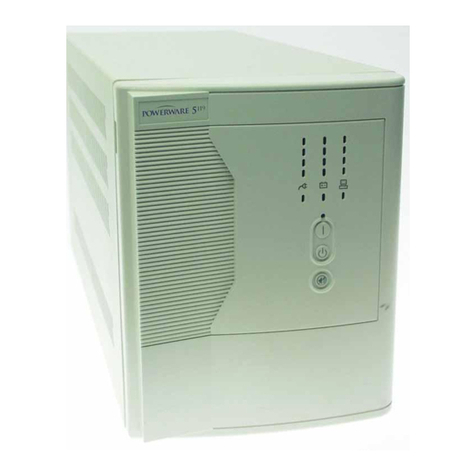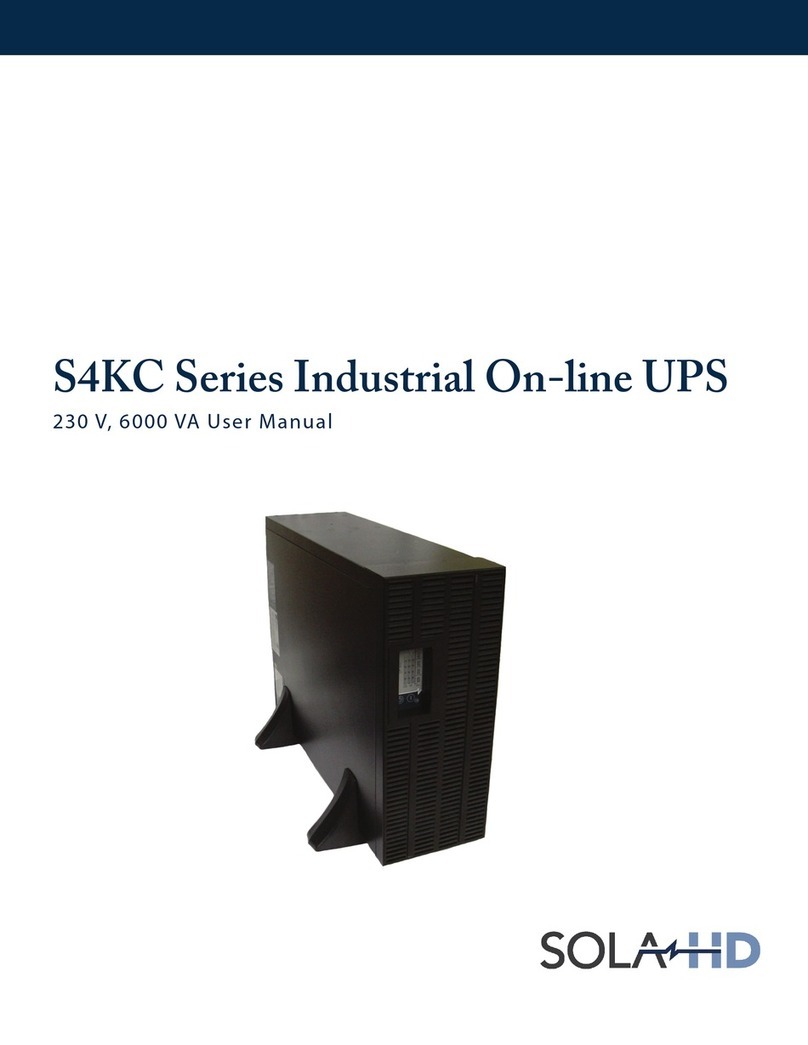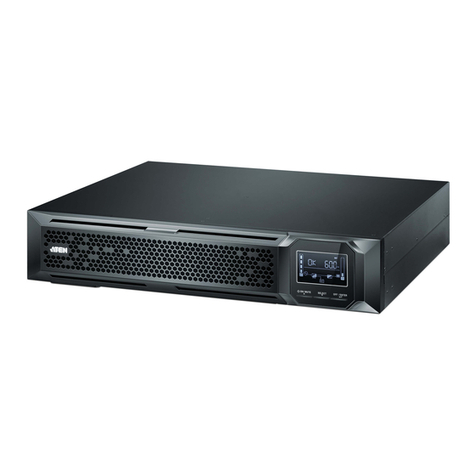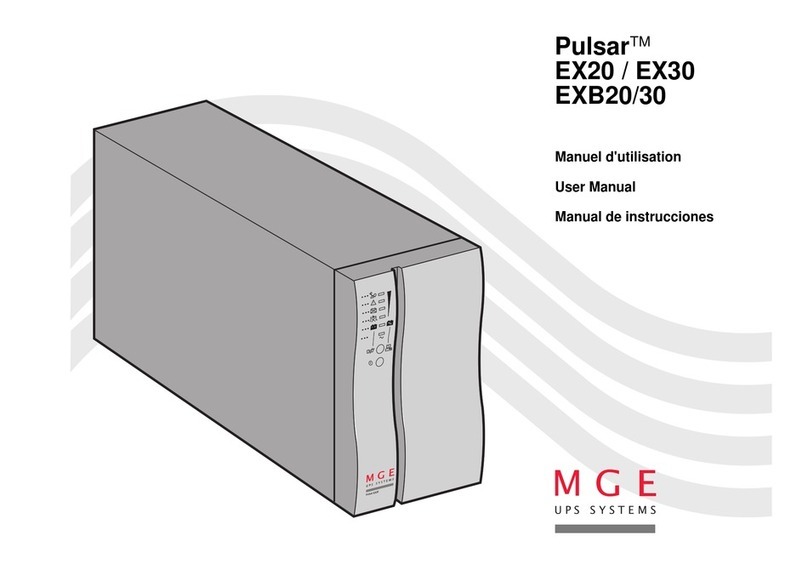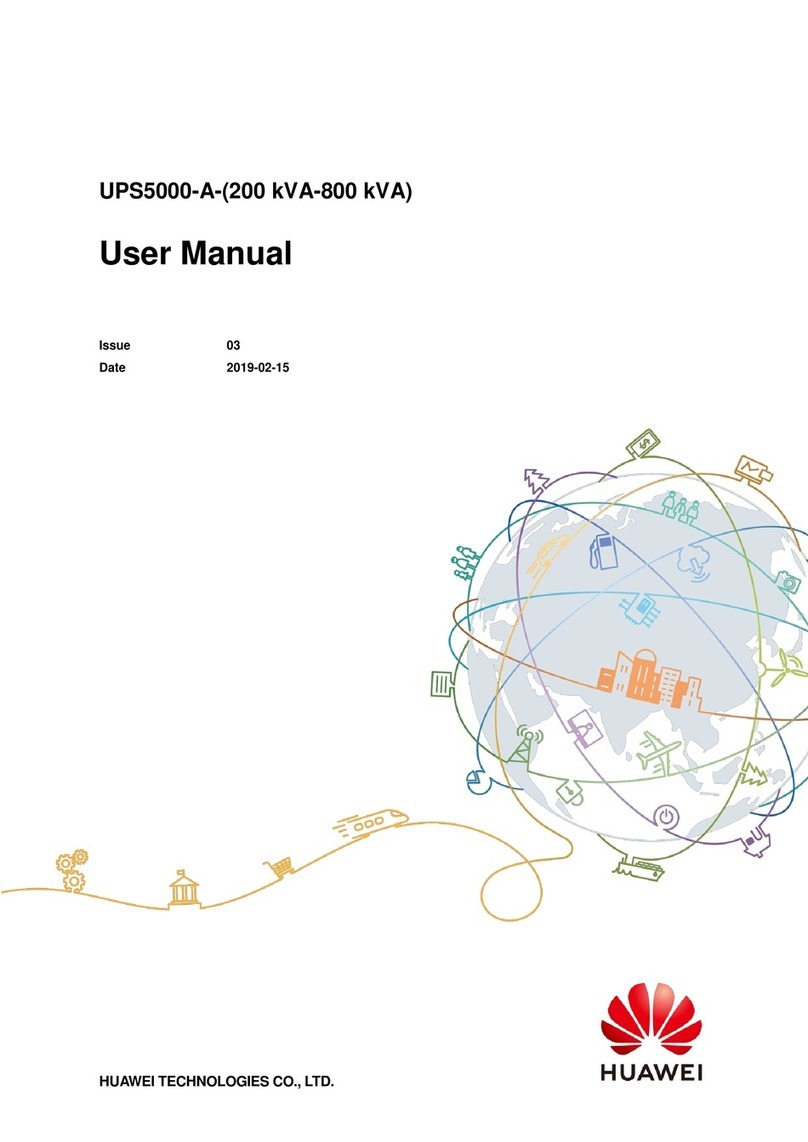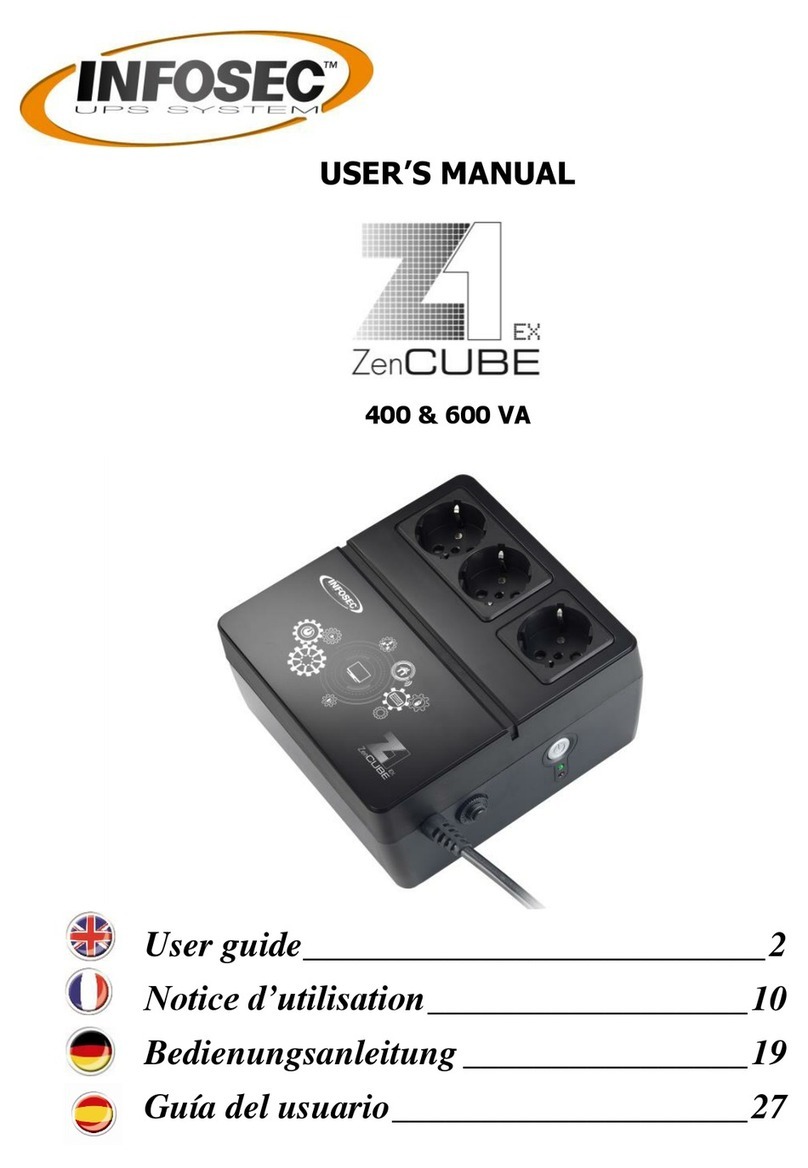Great Lakes XTREME GLUPS-ONLA-120 Guide

Great Lakes Data Racks & Cabinets Page 1
Online Lead Acid UPS
GLUPS-ONLA-120 and GLUPS-ONLA-240 Models
User & Installation Manual
d

Great Lakes Data Racks & Cabinets Page 2
Table of Contents
1. Important Safety Warning................................................................................................... 3
1-1. Transportation.....................................................................................................................................................3
1-2. Preparation ..........................................................................................................................................................3
1-3. Installation............................................................................................................................................................3
2. Installation and Setup.......................................................................................................... 6
2-1. REAR PANEL VIEW ..............................................................................................................................................6
2-2. Install the UPS .....................................................................................................................................................7
2-3. Setup the UPS .....................................................................................................................................................8
2-4. Battery Replacement ...................................................................................................................................... 12
2-5. Battery Kit Assembly....................................................................................................................................... 13
3. Operations .......................................................................................................................... 15
3-1. Button operation ............................................................................................................................................. 15
3-2. LCD Panel .......................................................................................................................................................... 15
3-3. Audible Alarm................................................................................................................................................... 17
3-4. LCD display wordings index........................................................................................................................... 17
3-5. UPS Setting ....................................................................................................................................................... 18
3-6. Operating Mode Description ........................................................................................................................ 23
3-7. Faults Reference Code.................................................................................................................................... 24
3-8. Warning indicator ............................................................................................................................................ 24
4. Troubleshooting ................................................................................................................. 25
5. Storage and Maintenance ................................................................................................. 26
6. Specifications...................................................................................................................... 27
ONLI 120V models: ................................................................................................................................................. 27
ONLI 240V models: .................................................................................................................................................. 27
Output Power Rating Table (120V models) ........................................................................................................ 28
Runtime Chart (internal battery)........................................................................................................................... 28
Battery Pack Specification...................................................................................................................................... 29
7. Obtaining Service ............................................................................................................... 30
8. Xtreme Power Conversion Limited Warranty.................................................................. 31
9. Xtreme Power Load Protection Policy .............................................................................. 32

Online Lead Acid User Manual
Great Lakes Data Racks & Cabinets Page 3
1. Important Safety Warning
SAVE THESE INSTRUCTIONS - This manual contains important instructions that should be followed during
installation and maintenance of the UPS and batteries.
Please comply with all warnings and operating instructions in this manual strictly. Do not operate this
unit before reading through all safety information and operating instructions carefully.
1-1. Transportation
•Please transport the UPS system only in the original package to protect against shock and impact.
1-2. Preparation
•Condensation may occur if the UPS system is moved directly from cold to warm environment. The
UPS system must be absolutely dry before being installed. Please allow at least two hours for the
UPS system to acclimate to the environment.
•Do not install the UPS system near water or in moist environments.
•Do not install the UPS system where it would be exposed to direct sunlight or near heater.
•Do not block ventilation holes in the UPS housing.
1-3. Installation
•Do not connect appliances or devices which would overload the UPS system (e.g.
laser printers) to the UPS output sockets.
•Place cables in such a way that no one can step on or trip over them.
•Do not connect domestic appliances such as hair dryers to UPS output sockets.
•The UPS can be operated by any individuals with no previous experience.
•Connect the UPS system only to an earthed shockproof outlet which must be
easily accessible and close to the UPS system.
•Please use only VDE-tested, CE-marked (for 240V models or UL-marked for 120V
models) mains cable (e.g. the mains cable of your computer) to connect the UPS
system to the building wiring outlet (shockproof outlet).
•Please use only VDE-tested, CE-marked (for 240V models or UL-marked for 120V models)
power cables to connect the loads to the UPS system.
•When installing the equipment, it should ensure that the sum of the leakage current of the
UPS and the connected devices does not exceed 3.5mA.
•Temperature Rating - Units are considered acceptable for use in a maximum ambient of
40°C (104°F).
For Pluggable Equipment - The socket-outlet shall be installed near the
equipment and shall be easily accessible.
•CAUTION: The unit is heavy. Lifting the unit requires a minimum of two people.
•Batteries with minimum case flame rating V-2 are intended for use in a computer room
as defined in the Standard for the Protection of Information Technology Equipment,
ANSI/NFAP 75. Batteries with case flame rating HB are not intended for use in a computer
room. (US installations only.)

Online Lead Acid User Manual
Great Lakes Data Racks & Cabinets Page 4
1-4. Operation
•Do not disconnect the mains cable on the UPS system or the building wiring
outlet (shockproof socket outlet) during operations since this would cancel the
protective earthing of the UPS system and of all connected loads.
•The UPS system features its own, internal current source (batteries). The UPS output
sockets or output terminals block may be electrically live even if the UPS system is
not connected to the building wiring outlet.
•In order to fully disconnect the UPS system, first press the OFF/Enter button to turn off
the unit.
•Prevent fluids or other foreign objects from inside of the UPS system.
•The EPO and USB circuits are an IEC 60950-1 safety extra low voltage (SELV) circuit.
This circuit must be separated from any hazardous voltage circuits by reinforced
insulation.
1-5. Maintenance, service and faults
•The UPS system operates with hazardous voltages. Repairs may be carried out only
by qualified maintenance personnel.
•Caution - risk of electric shock. Even after the unit is disconnected from the mains
(building wiring outlet), components inside the UPS system are still connected to the
battery and electrically live and dangerous.
•Before carrying out any kind of service and/or maintenance, disconnect the batteries
and verify that no current is present and no hazardous voltage exists in the terminals of
high capability capacitor such as BUS-capacitors.
•To avoid electrical shock, turn off the unit and unplug it form the AC power source
before servicing the battery
•Only persons adequately familiar with batteries and with the required precautionary
measures may replace batteries and supervise operations. Unauthorized persons must
be kept well away from the batteries.
•Caution - risk of electric shock. The battery circuit is not isolated from the input voltage.
Hazardous voltages may occur between the battery terminals and the
ground. Before touching, please verify that no voltage is present!
•Caution - Do not dispose of batteries in a fire. The batteries may explode.
•Caution - Do not open or mutilate batteries. Released electrolyte is harmful to the skin
and eyes. It may be toxic.
•A battery can may cause a risk of electrical shock and high short-circuit current.
The following precautions should be observed when working on batteries:
a) Remove watches, rings, or other metal objects.
b) Use tools with insulated handles.
c) Wear rubber gloves and boots.
d) Do not lay tools or metal parts on top of batteries.
e) Disconnect charging source prior to connecting or disconnecting
battery
terminals.

Online Lead Acid User Manual
Great Lakes Data Racks & Cabinets Page 5
f) Determine if battery is inadvertently grounded. If inadvertently grounded, remove
source from ground. Contact with any part of a grounded battery can
re
sul
t
in
electrical shock. The likelihood of such shock can be reduced if such grounds are
removed during installation and maintenance.
•When changing batteries, install the same number and same type of batteries or
battery packs.
•Please replace the fuse only with the same type and amperage in order to avoid
fire hazards.
•Do not dismantle the UPS system.
•WARNING: This is a category C2 UPS product. In a residential environment, this
product may cause radio interference, in which case the user many be required to take
additional measures. (only for CE models)
•NOTE: This equipment has been tested and found to comply with the limits for a Class A
digital device, pursuant to part 15 of the FCC Rules. These limits are designed to provide
reasonable protection against harmful interference when the equipment is operated in a
commercial environment. This equipment generates, uses, and can radiate radio
frequency energy and, if not installed and used in accordance with the instruction manual,
may cause harmful interference to radio communications. Operation of this equipment in
a residential area is likely to cause harmful interference in which case the user will be
required to correct the interference at his own expense.
•WARNING: Changes or modifications not expressly approved by the party responsible
for compliance could void the user's authority to operate the equipment.

Online Lead Acid User Manual
Great Lakes Data Racks & Cabinets Page 6
2. Installation and Setup
NOTE: Before installation, please inspect the unit. Be sure that nothing inside the package is damaged.
Please keep the original package in a safe place for future use.
2-1. REAR PANEL VIEW
ONLI-240 MODELS
1500 Model 2000 Model
3000 Model
ONLI-120 MODELS
1000/1500 Model 2000 Model
3000 Model
Programmable outlets: connect to non-critical loads.
1. Output receptacles: connect to mission-critical
loads.
2. AC input
3. Network/Fax/Modem surge protection
4. USB communication port
5. RS-232 communication port
6. SNMP intelligent slot
7. Emergency power off function connector
(EPO)
8. External battery connection
9. Output circuit breaker2-2. Operating principle

Online Lead Acid User Manual
Great Lakes Data Racks & Cabinets Page 7
The operating principle of the UPS is shown as below
The UPS is composed of mains input, EMI/RFI filters, rectifier/PFC, inverter, battery charger, DC-to-DC
converter, battery, dynamic bypass and UPS output.
2-2. Install the UPS
This UPS can be either displayed on the desk or mounted in the 19” rack chassis. Please choose
proper installation to position this UPS.
RACK-MOUNT INSTALLATION
Step 1 Step 2
UPS
TO
WER INSTALLATION
Step 1 Step 2 Step 3

Online Lead Acid User Manual
Great Lakes Data Racks & Cabinets Page 8
TOWER INSTALLATION WITH BATTERY PACK
Step 1 Step
2
2-3. Setup the UPS
Before installing the UPS, please read below to select proper location to install UPS.
1. UPS should be placed on the flat and clean surface. Place it in an area away from vibration, dust,
humidity, high temperature, flammable liquids, gas, corrosive and conductive contaminants.
Install the UPS indoors in a clean environment, where it is away from window and door. Maintain
minimum clearance of 100mm in the bottom of the UPS to avoid dust and high temperature.
2. Place UPS:
3. It’s equipped with fan for cooling. Therefore, place the UPS in a well-ventilated area. It’s required to
maintain minimum clearance of 100mm in the front of the UPS and 300mm in the back and two
sides of the UPS for heat dissipation and easy-maintenance.
Step 1: External battery connection
For safety consideration, the UPS is shipped out from factory without connecting battery wires. Before
connecting to external batteries, it’s required to have the internal battery wire disconnected. Follow the
below steps to make external battery connection.
1. Turn off UPS and remove power plug from the mains.
2. Remove front panel and disconnect internal battery wire.

Online Lead Acid User Manual
Great Lakes Data Racks & Cabinets Page 9
Battery
Pack 2
Battery
Pack 1
3. Remove the cover of the external battery connector by using a screwdriver.
4. Plug the battery cable into the external battery connector of the UPS and the
battery pack(s).
Note: If you have multiple battery packs available, connect them serially. An example is shown
in the diagram below (connecting the second battery connector of the first battery pack to the
first battery connector of the second battery pack).
5. Stabilize the connector to the UPS and the battery pack(s) by
fixing screws as shown below diagram
6. Connect internal battery connector and put the front panel back to the unit.

Online Lead Acid User Manual
Great Lakes Data Racks & Cabinets Page 10
Step 2: UPS input connection
Plug the UPS into a two-pole, three-wire, grounded receptacle only. Avoid using extension cords.
•
F
or 240V models: The power cord is supplied in the UPS package.
•For 120V models: The power cord is attached to the UPS. The input plug is a NEMA 5-15P for 1000
and 1500 models, NEMA 5-20P for 2000 model and NEMA L5-30P for 3000 model.
•To reduce the risk of fire, connect only to a circuit provided with (@) a maximum branch circuit
overcurrent protection in accordance with the National Electrical Code, ANSI/NFPA 70 and the
Canadian Electrical Code, Part I, C22.1.
Mo
de
l
(@)
ONLA-120/240-1000
20A
ONLA-120/240-1500
20A
ONLA-120/240-2000
20A
ONLA-120/240-3000
40A
Step 3: UPS output connection
There are two kinds of outputs: programmable outlets and general outlets. Please connect
non-critical devices to the programmable outlets and critical devices to the general outlets. During power
failure, you may extend the backup time to critical devices by setting shorter backup time for non-critical
devices.
Step 4: Communication connection
Communication port:
USB port RS-232 port Intelligent slot
To allow for unattended UPS shutdown/start-up and status monitoring, connect the communication cable
one end to the USB/RS-232 port and the other to the communication port of your PC. With the monitoring
software installed, you can schedule UPS shutdown/start-up and monitor UPS status through PC.
The UPS is equipped with intelligent slot perfect for either SNMP or AS400 card. When installing either
SNMP or AS400 card in the UPS, it will provide advanced communication and monitoring options.
Step 5: Network connection
Network/Fax/Phone surge port
Connect a single modem/phone/fax line into surge-protected “IN” outlet on the back panel of the
UPS unit. Connect from “OUT” outlet to the equipment with another modem/fax/phone line cable.

Online Lead Acid User Manual
Great Lakes Data Racks & Cabinets Page 11
Step 6: Disable and enable EPO function
This UPS is equipped with EPO function. By default, the UPS is delivered from factory with Pin 1 and pin 2
closed (a metal plate is connected to Pin 1 and Pin2) for UPS normal operation. To activate EPO function,
remove two screws on EPO port and metal plate will be removed.
Note: The EPO function logic can be set up via LCD setting. Please refer to program 16 in UPS setting
for the details.
Step 7: Turn on the UPS
Press the ON/Mute button on the front panel for two seconds to power on the UPS.
Note: The battery charges fully during the first five hours of normal operation. Do not expect full battery
run capability during this initial charge period.
Step 8: Install software
For optimal computer system protection, install UPS monitoring software to fully configure UPS shutdown.
Use supplied RS-232 or USB communication cable to connect RS-232/USB port of UPS and RS-232/USB
port of PC. Then, follow below steps to install monitoring software.
1. Insert the included installation CD into CD-ROM drive and then follow the on-screen instructions to
proceed software installation. If there no screen shows 1 minute after inserting the CD, please
execute setup.exe file for initiating software installation.
2. Follow the on-screen instructions to install the software.
3. When your computer restarts, the monitoring software will appear as an orange plug icon located in
the system tray, near the clock.
It’s in closed status for UPS
normal operation as default.
To activate EPO
function, remove
these two screws.

Online Lead Acid User Manual
Great Lakes Data Racks & Cabinets Page 12
2-4. Battery Replacement
When the icons of and are flashing in LCD display and alarm is sounding every 2 seconds, it’s
time to replace batteries. Contact your service representative to replace batteries.
Do not disconnect battery connectors under load. If you prefer to remove input power to change the
batteries, press the OFF button on the front panel for two seconds to power off the UPS and switch off
utility power where the UPS is connected.
NOTE 1: DO NOT DISCONNECT the batteries while the UPS is in Battery mode.
NOTE 2: A small amount of arcing may occur when connecting the internal batteries. This is normal
condition and no harm for personnel. Connect the cables quickly and firmly.
NOTE 3: This UPS is equipped with internal batteries and only service person can replace the batteries.
NOTE 4: Upon battery disconnection, equipment is not protected from power outages.
CAUTION!! Consider all warnings, cautions, and notes before replacing batteries.
Step 1
Step 2
Step 3
Remove front panel.
Disconnect battery wires.
Pull out the battery box by
removing two screws on the
front panel.
Step 4
Step 5
Step 6
Remove the top cover of the
battery box and replace the
inside batteries.
After replacing the batteries, put
the battery box back to original
location and screw it tightly
Reconnect the battery wires
Step 7
Put the front panel back on the
unit

Online Lead Acid User Manual
Great Lakes Data Racks & Cabinets Page 13
2-5. Battery Kit Assembly
NOTICE: Please assemble battery kit first before installing it inside of UPS. Please select correct
battery kit procedure below to assemble it.
2-BATTERY KIT
Step 1
Step 2
Remove adhesive straps
Connect all battery terminals, follow above diagram
Step 3
Step 4
Put assembled battery packs on one side of
plastic shells
Cover the other side of plastic shell as shown in above
diagram. Battery kit is now assembled.
3-BATTERY KIT
Step 1
Step 2
Remove adhesive tapes
Connect all battery terminals, follow above diagram.
Step 3
Step 4
Put assembled battery packs on one side of
plastic shells
Cover the other side of plastic shell as shown in above
diagram. Battery kit is now assembled.

Online Lead Acid User Manual
Great Lakes Data Racks & Cabinets Page 14
4-BATTERY KIT
Step 1
Step 2
Remove adhesive tapes
Connect all battery terminals, follow above diagram.
Step 3
Step 4
Put assembled battery packs on one side of
plastic shells
Cover the other side of plastic shell as shown in
above diagram. Battery kit is now assembled.
6-BATTERY KIT
Step 1
Step 2
Remove adhesive tapes
Connect all battery terminals, follow above diagram
Step 3
Step 4
Put assembled battery packs on one side of
plastic shells
Cover the other side of plastic shell as shown in
above diagram. Battery kit is now assembled.
TAPE
TAPE
TAPE
TAPE

Online Lead Acid User Manual
Great Lakes Data Racks & Cabinets Page 15
3. Operations
3-1. Button operation
Button Function
O
N
/
Mute
B
utton
›
Turn on the UPS: Press and hold ON/Mute button for at least 2 seconds to
›turn on the UPS.
›Mute the alarm: After the UPS is turned on in battery mode, press and hold this
button for at least 3 seconds to disable or enable the alarm system. But it’s not
applied to the situations when warnings or errors occur.
›Up key: Press this button to display previous selection in UPS setting mode.
›Switch to UPS self-test mode: Press ON/Mute buttons for 3 seconds to enter
›UPS self-testing while in AC mode, ECO mode, or converter mode.
OFF/Enter
Button
›Turn off the UPS: Press and hold this button at least 2 seconds to turn off the
UPS. UPS will be in standby mode under power normal or transfer to Bypass
mode if the Bypass enable setting is set by pressing this button.
›Confirm selection key: Press this button to confirm selection in UPS setting
mode.
Select
Button
›
Switch LCD message: Press this button to change the LCD message for input
›voltage, input frequency, input current, battery voltage, battery current, battery
capacity, ambient temperature, output voltage, output frequency, load current
and load percent.
›Setting mode: Press and hold this button for 3 seconds to enter UPS setting
mode when Standby and Bypass mode.
›Down key: Press this button to display next selection in UPS setting mode.
ON/Mute
+ Select
Button
›Switch to bypass mode: When the main power is normal, press ON/Mute and
›Select buttons simultaneously for 3 seconds. Then UPS will enter to bypass
mode. This action will be ineffective when the input voltage is out of acceptable
range.
›Exit setting mode or return to the upper menu: When working in s
et
ting
m
o
de,
press ON/Mute and Select buttons simultaneously for 0.2 seconds to return to
the upper menu. If it’s already in top menu, press these two buttons at the
same time to exit the setting mode.
3-2. LCD Panel

Online Lead Acid User Manual
Great Lakes Data Racks & Cabinets Page 16
Display
Function
Backup time information
Indicates the estimated backup time.
H: hours, M: minute, S: second.
Configuration and fault information
Indicates the configuration items, and the configuration items are listed in details in
section 3-5.
Indicates the warning and fault codes, and the codes are listed in details in section 3-
7 and 3-8.
Mute operation
Indicates that the UPS alarm is disabled.
Input, Battery, Temperature, Output & Load information
Indicates the input voltage, input frequency, input current, battery voltage, battery
current, battery capacity, ambient temperature, output voltage, output frequency,
load current and load percent.
k: kilo, W: watt, V: voltage, A: ampere, %: percent,
℃
: centigrade degree, Hz: frequency
Load information
Indicates the load level by 0-24%, 25-49%, 50-74% and 75-100%.
Indicates overload.
Programmable outlets information
Indicates that programmable management outlets are working.
Mode operation information
Indicates the UPS connects to the mains.
Indicates the battery is working.
Indicates charging status
Indicates the bypass circuit is working.
Indicates the ECO mode is enabled.
Indicates the AC to DC circuit is working.
Indicates the PFC circuit is working.
Indicates the inverter circuit is working.
Indicates the UPS is working in converter mode.
Indicates the output is working.
Battery information
Indicates the battery level by 0-24%, 25-49%, 50-74%, and 75-100%.
Indicates low battery.

Online Lead Acid User Manual
Great Lakes Data Racks & Cabinets Page 17
3-3. Audible Alarm
Battery Mode Sounding every 5 seconds
Low Battery Sounding every 2 seconds
Overload Sounding every second
Fault Continuously sounding
Bypass Mode Sounding every 10 seconds
3-4. LCD display wordings index
Abbreviation Display content Meaning
ENA
Enable
DIS
Disable
ESC
Escape
HLS
High loss
LLS
Low loss
AO
Active open
AC
Active close
EAT
Estimated autonomy time
RAT
Running autonomy time
SD
Shutdown
OK
OK
ON
ON
BL
Battery Low
OL
Over Load
OI
Over input current
NC
Battery No Connect
OC
Over Charge
SF
Site wiring fault
EP
EPO
TP
Temperature
CH
Charger
BF
Battery Fault
BV
Bypass Out Range
FU
Bypass frequency unstable
BR
Battery Replace
EE
EEPROM error

Online Lead Acid User Manual
Great Lakes Data Racks & Cabinets Page 18
3-5. UPS Setting
There are three parameters to set up the UPS. Parameter 1: It’s for
program alternatives. Refer to below table.
Parameter 2 is the setting options or values for
each program.
output voltage is 125Vac
01: Output voltage setting
Interface
Setting
Parameter 2: Output voltage
For 240V models, you may choose the following output voltage:
200: presents output voltage is 200Vac
208: presents output voltage is 208Vac
220: presents output voltage is 220Vac
230: presents output voltage is 230Vac (Default)
240: presents output voltage is 240Vac
For 120V models, you may choose the following output voltage:
100: presents output voltage is 100Vac
110: presents output voltage is 110Vac
115: presents output voltage is 115Vac
120: presents output voltage is 120Vac (Default)
125: presents output voltage is 125Vac
02: Frequency Converter enable/disable
Interface
Setting
Parameter 2: Enable or disable converter mode. You may choose
the following two options:
CF ENA:
converter mode enable
CF DIS:
converter mode disable (Default)
03: Output frequency setting
Interface
Setting
Parameter 2: Output frequency setting.
You may set the initial frequency on battery mode:
BAT 50: presents output frequency is 50Hz
BAT 60: presents output frequency is 60Hz
If converter mode is enabled, you may choose the following output
frequency:
CF 50: presents output frequency is 50Hz
CF 60: presents output frequency is 60Hz

Online Lead Acid User Manual
Great Lakes Data Racks & Cabinets Page 19
04: ECO enable/disable
Interface
Setting
Parameter 2:
Enable or disable ECO function. You may choose the
following two options:
ENA:
ECO mode enable
DIS:
ECO mode disable (Default)
05: ECO voltage range setting
Interface
Setting
Parameter 2: Set the acceptable high voltage point and low
voltage point for ECO mode by pressing Down key or Up key.
HLS:
High loss voltage in ECO mode in parameter 2.
For 240V models, the setting range in parameter 3 is from +7V to
+24V of the nominal voltage. (Default: +12V)
For 120V models, the setting range in parameter 3 is from +3V to
+12V of the nominal voltage. (Default: +6V)
LLS:
Low loss voltage in ECO mode in parameter 2.
For 240V models, the setting range in parameter 3 is from -7V to
-24V of the nominal voltage. (Default: -12V)
For 120V models, the setting voltage in parameter 3 is from -3V
to -12V of the nominal voltage. (Default: -6V)
06: Bypass enable/disable when UPS is off
Interface
Setting
Parameter 2: Enable or disable Bypass function. You may choose
the following two options:
ENA:
Bypass enable
DIS:
Bypass disable (Default)

Online Lead Acid User Manual
Great Lakes Data Racks & Cabinets Page 20
07: Bypass voltage range setting
Interface
Setting
Parameter 2: Set the acceptable high voltage point and
acceptable low voltage point for Bypass mode by pressing the
Down key or Up key.
HLS:
Bypass high voltage point
For 240V models:
230-264:
setting the high voltage point from 230Vac to 264Vac. (Default
:
264Vac)
For 120V models:
120-140:
setting the high voltage point from 120Vac to 140Vac. (Default
:
132Vac)
LLS:
Bypass low voltage point
For 240V models
170-220:
setting the low voltage point from 170Vac to 220Vac. (Default:
170Vac)
For 120V models:
85-115:
setting the low voltage point from 85Vac to 115Vac.
(Default: 85 Vac)
08: Bypass frequency range setting
Interface
Setting
Parameter 2: Set the acceptable high frequency point and
acceptable low frequency point for Bypass mode by pressing the
Down key or Up key.
HLS:
Bypass high frequency point
For 50Hz output frequency models:
51-55Hz:
setting the frequency high loss point from 51Hz to
55HZ. (Default: 53.0Hz)
For 60Hz output frequency models:
61-65Hz:
setting the frequency high loss point from 61Hz to
65Hz. (Default: 63.0Hz)
LLS:
Bypass low Frequency point
For 50Hz output frequency models:
45-49Hz:
setting the frequency low loss point from 45Hz to
49HZ. (Default: 47.0Hz)
For 60Hz output frequency models:
55-59Hz:
setting the frequency low loss point from 55Hz to
59Hz. (Default: 57.0Hz)
09: Programmable outlets enable/disable
Interface
Setting
Parameter 2: Enable or disable programmable outlets.
ENA:
Programmable outlets enable
DIS:
Programmable outlets disable (Default)
This manual suits for next models
9
Table of contents
Other Great Lakes UPS manuals

